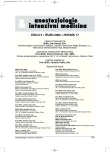-
Medical journals
- Career
Duration of rocuronium-induced neuromuscular block predicted by its dose and onset time: a prospective study
Authors: M. Adamus 1; P. Adamus 2; R. Bělohlávek 3; M. Vujčíková 1; E. Janásková 1
Authors‘ workplace: Klinika anesteziologie a resuscitace, LF Univerzity Palackého a Fakultní nemocnice, Olomouc 1; Rapid System, s. r. o., Olomouc 2; Katedra informatiky, PřF Univerzity Palackého, Olomouc 3
Published in: Anest. intenziv. Med., 17, 2006, č. 5, s. 241-245
Category: Anaesthesiology - Original Paper
Overview
Objective:
Following a bolus dose of rocuronium, the average duration of neuromuscular block until 25% recovery (= clinical duration) can be predicted by the dose-duration relationship. In the present study we investigated whether the predictive power could be improved by the addition of another independent variable – onset time.Design:
Clinical, prospective, randomized, controlled study.Settings:
Department of Anaesthesiology and Intensive Care, University Hospital, Olomouc.Materials and Methods:
Following local ethics committee approval and obtaining informed consent, 350 patients scheduled for elective surgery under total intravenous anaesthesia with tracheal intubation were randomized into 7 groups with different rocuronium doses administered (0.30; 0.45; 0.60; 0.75; 0.90; 1.05; 1.20 mg . kg⁻¹, respectively). For each consecutive patient the onset time for 95% depression of T1 and clinical duration until 25% recovery were determined. To predict clinical duration for different values of two independent variables (dose and onset time), statistical analyses were performed by simple and multiple linear regression (least-square method). The squared correlation coefficient (r²) was used as the primary criterion for the evaluation of each model. In addition, the possible useful effect of different transformations of the variables was studied.Results:
The duration of action was better predicted by dose (r² = 0.64) than by onset time (r² = 0.59). The predictability of clinical duration was improved by combining the two independent variables (dose and onset time) in a multiple regression model (r² = 0.68). The explanatory power was further increased when using the logarithm of clinical duration as the dependent variable (r² = 0.72). Conclusion: The duration of rocuronium-induced neuromuscular block can be predicted more precisely by the combined use of dose and onset time than by dose (or onset time) alone. The addition of an individual response parameter, the onset time, improved the prediction of the duration of action.Key words:
neuromuscular block – rocuronium – clinical duration – onset time – simple and multiple linear regression analysis
Labels
Anaesthesiology, Resuscitation and Inten Intensive Care Medicine
Article was published inAnaesthesiology and Intensive Care Medicine

2006 Issue 5-
All articles in this issue
- Administration of COX-2 inhibitors modifies the course of postoperative delirium in cardiac surgery patients
- Duration of rocuronium-induced neuromuscular block predicted by its dose and onset time: a prospective study
- Fuzzy logic in anaesthesiology as a way of thinking and a tool for practical applications
- Attitudes of intensivists to limiting therapy and end of life decision in the Czech Republic – a national study
- Limitation of therapy in patients on ICU – a one-day national study
- Extreme hypoxic lactaemia in patients on critical care – prognosis, therapeutic options and their limitations
- Anaesthesiology and Intensive Care Medicine
- Journal archive
- Current issue
- Online only
- About the journal
Most read in this issue- Extreme hypoxic lactaemia in patients on critical care – prognosis, therapeutic options and their limitations
- Limitation of therapy in patients on ICU – a one-day national study
- Fuzzy logic in anaesthesiology as a way of thinking and a tool for practical applications
- Administration of COX-2 inhibitors modifies the course of postoperative delirium in cardiac surgery patients
Login#ADS_BOTTOM_SCRIPTS#Forgotten passwordEnter the email address that you registered with. We will send you instructions on how to set a new password.
- Career

